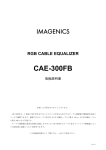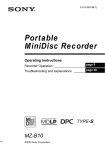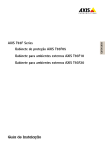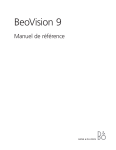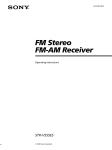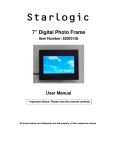Download IBM 4685-K03 User's Manual
Transcript
IBM 4685-K03 POS Keyboard Installation, Operation, and Maintenance Guide P/N 29R0777 IBM is a trademark of the IBM Corporation in the United States or other countries. First Edition (May 2006) This manual is revised in accordance with product improvements or for other reasons. © Copyright International Business Machines Corporation 2006. All rights reserved. Introduction This manual provides an overview, installation instructions, operating guidelines, instructions on how to replace the keys, and general maintenance information for the IBM™ 4685-K03 POS Keyboard. In this manual, the IBM 4685-K03 POS Keyboard may be referred to as the 4685-K03 or as the keyboard. The IBM 4800 POS terminal may be referred to as the POS terminal or as the terminal. This manual is organized as follows: z Chapter 1, “An overview of the IBM 4685-K03 POS Keyboard” provides an overview of this product and gives the names of the parts. z Chapter 2, “Installing the keyboard” provides information about installing the keyboard in the IBM 4800 POS terminal. z Chapter 3, “Operating the keyboard” provides information about operating procedures for the keyboard and the functions of each part. z Chapter 4, “Replacing the keys” provides information about exchange procedures for the keys and for the unused key covers. z Chapter 5, “Maintenance of the keyboard” provides information about problem-solving strategies and part replacement procedures. This section is for service personnel who specialize in maintaining the POS terminal. _________________________________________________________________________________________ Who should use this guide This manual is to be used by service personnel who install the IBM 4685-K03 POS Keyboard and by customers. Information for service engineers who specialize in the POS terminal is included in Chapter 5, “Maintenance of the keyboard”. _________________________________________________________________ End of life disposal This unit must be recycled or discarded according to applicable local and national regulations. IBM encourages owners of information technology (IT) equipment to responsibly recycle their equipment when it is no longer needed. IBM offers a variety of product return programs and services in various countries to assist equipment owners in recycling their IT products. Information on IBM product recycling offerings can be found on IBM’s Internet site at http://www.ibm.com/ibm/environment/products/prp.shtml. Introduction iii _________________________________________________________________ Notices _________________________________________________________________________________________ Electronic Emission Notices Japanese Voluntary Control Council for Interference (VCCI) Statement This product is Class A Information Technology Equipment and conforms to the standards set by the Voluntary Control Council for Interference by Technology Equipment (VCCI). In a domestic environment this product may cause radio interference, in which case the user may be required to take adequate countermeasures. この装置は、情報処理装置等電波障害自主規制協議会(VCCI)の基準に基づくクラスA情報技術装 置です。この装置を家庭環境で使用すると電波妨害を引き起こすことがあります。この場合には使用者 が適切な対策を講ずるよう要求されることがあります。 Korean Communications Statement Please note that this device has been approved for business purposes with regard to electromagnetic interference. If you find this is not suitable for your use, you may exchange it for a non-business purpose device. _________________________________________________________________________________________ Electrostatic Discharge (ESD) Attention: ESD damage can occur when there is a difference in charge between the part, the product, and the service person. No damage will occur if the service person and the part being installed are at the same charge level. ESD Damage Prevention Anytime a service action involves physical contact with logic cards, modules, back-panel pins, or other ESD-sensitive (ESDS) parts, the service person must be connected to an ESD common ground point on the product through an ESD wrist strap and cord. The ESD ground clip can be attached to any frame ground, ground braid, green wire ground, or the round ground prong on the AC power plug. Coax or connector external shells can also be used. iv IBM 4685-K03 Installation, Operation and Maintenance Guide Handling Removed Cards Logic cards removed from a product should be placed in ESD protective containers. No other object should be allowed inside the ESD container with the logic card. Attach tags or reports that must accompany the card to the outside of the container. _________________________________________________________________ Related Publications For related information, please see the following websites: z http://www.ibm.com/jp/store/ z http://www.pc.ibm.com/store/ vi IBM 4685-K03 Installation, Operation and Maintenance Guide Safety Information for Users Safety Instructions vii Safety Information for service personnel Before you begin to install or service this product, please read the following safety information. Note: In these notices, the term, qualified service personnel, refers to a person with the skills to perform a PC upgrade. _________________________________________________________________________________________ Safety Information for Japan viii IBM 4685-K03 Installation, Operation and Maintenance Guide Safety Instructions ix _________________________________________________________________________________________ Safety Information for Korea x IBM 4685-K03 Installation, Operation and Maintenance Guide Safety Instructions xi Contents INTRODUCTION..................................................................................................................................................................... III WHO SHOULD USE THIS GUIDE........................................................................................................................................ III END OF LIFE DISPOSAL...................................................................................................................................................... III NOTICES.................................................................................................................................................................................. IV ELECTRONIC EMISSION NOTICES ................................................................................................................................................ IV Japanese Voluntary Control Council for Interference (VCCI) Statement ...............................................................iv Korean Communications Statement.............................................................................................................................. iv ELECTROSTATIC DISCHARGE (ESD)........................................................................................................................................... IV RELATED PUBLICATIONS.....................................................................................................................................................V SAFETY INFORMATION FOR USERS...............................................................................................................................VII SAFETY INFORMATION FOR SERVICE PERSONNEL................................................................................................ VIII SAFETY INFORMATION FOR JAPAN ............................................................................................................................. VIII SAFETY INFORMATION FOR KOREA .................................................................................................................................X CHAPTER 1 “AN OVERVIEW OF THE IBM 4685-K03 POS KEYBOARD”......................................................................1 AN OVERVIEW ..........................................................................................................................................................................1 CONFIRMATION OF PRODUCT .............................................................................................................................................2 4685-K03 MODEL........................................................................................................................................................................ 2 PARTS NAME ............................................................................................................................................................................2 4685-K03 MODEL ........................................................................................................................................................................ 2 KEY LAYOUT AT SHIPMENT TIME ........................................................................................................................................3 4685-K03 MODEL ........................................................................................................................................................................ 3 CHAPTER 2 “INSTALLING THE KEYBOARD”....................................................................................................................5 INSTALLATION FOR IBM 4800 POS TERMINAL.................................................................................................................5 CHAPTER 3 “OPERATING THE KEYBOARD”....................................................................................................................9 SYSTEM KEYS ..........................................................................................................................................................................9 VOLUME ADJUSTMENT..........................................................................................................................................................9 MODE SWITCH........................................................................................................................................................................11 4-POSITION MODE KEY ................................................................................................................................................................ 11 HOW TO SWIPE A CARD THROUGH THE MSR .............................................................................................................. 12 Contents xiii DAILY CARE............................................................................................................................................................................ 12 CHAPTER 4 “REPLACING THE KEYS”............................................................................................................................. 15 REPLACING A SINGLE KEY................................................................................................................................................ 15 REMOVAL....................................................................................................................................................................................15 ATTACHING .................................................................................................................................................................................16 REPLACING A DOUBLE KEY.............................................................................................................................................. 17 REMOVAL....................................................................................................................................................................................17 ATTACHING .................................................................................................................................................................................18 REPLACING A QUADRUPLE KEY...................................................................................................................................... 19 REMOVAL....................................................................................................................................................................................19 ATTACHING .................................................................................................................................................................................19 CHAPTER 5 “MAINTENANCE OF THE KEYBOARD”..................................................................................................... 21 IF PROBLEMS OCCUR......................................................................................................................................................... 21 DIAGNOSTIC TESTS............................................................................................................................................................. 22 SELF-DIAGNOSTIC TESTS............................................................................................................................................................22 REMOVING AND REPLACING PARTS............................................................................................................................... 24 REPLACING THE REAR COVER ....................................................................................................................................................24 REPLACING THE CONTROL CARD ...............................................................................................................................................25 REPLACING THE MSR................................................................................................................................................................25 REPLACING THE MODE KEY ........................................................................................................................................................27 REPLACING THE SPEAKER..........................................................................................................................................................27 REPLACING THE TOP COVER ASSEMBLY.....................................................................................................................................27 BILL OF MATERIAL ............................................................................................................................................................... 28 ASSEMBLY: KEYBOARD..............................................................................................................................................................28 APPENDIX A. ACCESSORY UNIT....................................................................................................................................... 31 ACCESSORY UNITS .....................................................................................................................................................................31 APPENDIX B. PRODUCT SPECIFICATIONS..................................................................................................................... 33 DIMENSIONS ...............................................................................................................................................................................33 CONSUMPTION CURRENT ...........................................................................................................................................................33 ENVIRONMENT CONDITION..........................................................................................................................................................33 MSR READABLE CARDS..................................................................................................................................................... 33 xiv IBM 4685-K03 Installation, Operation and Maintenance Guide Chapter 1 “An overview of the IBM 4685-K03 POS Keyboard” This chapter provides an overview of the IBM 4685-K03 POS Keyboard, explains how to confirm the identification of the product, gives the names of the parts, and describes the key layout at time of shipment. _________________________________________________________________________________________ An overview The IBM 4685-K03 POS keyboard is equipped with an MSR (Magnetic Stripe Reader). The 4685-K03 keyboard is to be connected to an IBM 4800 POS terminal. This keyboard connects using the IBM RS-485 or powered USB, but using both interfaces at the same time is not supported. Connecting two different interface cables at the same time may damage the keyboard. The primary hardware configuration for the 4685-K03 is as follows: 4685-K03 Key matrix At shipment 12 rows × 7 columns Single keys 54 pieces Double keys 4 pieces MSR Read only Mode key 4 positions Interfaces RS-485, Powered USB Chapter1 Outline for 4685-K03 POS Keyboard 1 _________________________________________________________________________________________ Confirmation of product Confirm the following parts are included. 4685-K03 Model □ Mode keys Label 1 □ 4685-K03 Keyboard □ Mode keys Operator Key (“OP”) 2 pieces Manager Key (“MGR”) 2 pieces □ Keys 1 set (Single keys: 54 pieces Double keys: 4 pieces) 2 IBM 4685-K03 Installation, Operation and Maintenance Guide □ Removal tool for key caps _________________________________________________________________________________________ Parts name 4685-K03 model Mode switch System keys S1 S2 MSR 2 IBM 4685-K03 Installation, Operation and Maintenance Guide _________________________________________________________________________________________ Key layout at shipment time 4685-K03 model Chapter 1 Outline for IBM 4685-K02 POS Keyboard 3 Chapter 2 “Installing the keyboard” This section explains how the Keyboard is installed on the IBM 4800 POS terminal. _________________________________________________________________________________________ Installation for IBM 4800 POS terminal This section explains how Keyboard is installed on the IBM 4800 POS terminal (also referred to as the system device). 1. Connect the keyboard cable 5 to the keyboard. Notes: a. Turning the keyboard over and looking from the front side, connect the keyboard cable 5 to the right side socket of the two connections. Connector Keyboard cable 5 b. If also installing the video display, it should be installed before going on to Step 2. After the display is connected, continue with Step 2, “With the video display”. (See the instruction manual that comes with the IBM 4800 POS terminal for more information about how to install the video display.) 2. Plug the other connector on the keyboard cable into the system device as shown in the following figure, routing it through the back side of the system device. Chapter 2 Installing the keyboard 5 With the video display Without the video display 3. 6 Put the keyboard in place on the system device. IBM 4685-K03 Installation, Operation and Maintenance Guide 4. Connect the keyboard cable to the system device. (See the instruction manual that comes with the IBM 4800 POS terminal for more information about how to connect the keyboard cable to the system device.) Chapter 2 Installing the keyboard 7 Chapter 3 “Operating the keyboard” This chapter explains the operating procedures and the functions of the parts. _________________________________________________________________________________________ System keys The system keys are used to input system functions, which are run under the control of a program. Regarding the usage of these keys, please refer to the operating manual in your store or call your system representatives. The layout of the system keys is shown in the following chart. System keys S1 S2 _________________________________________________________________________________________ Volume adjustment The volume adjustment adjusts the speaker volume when keys are pressed. To maximize the volume, turn the volume adjustment control all the way to the right. To minimize the sound, turn it all the way to the left. MAX MIN Chapter 3 Operating the keyboard 9 Notes: 1. Use your fingers, not a tool, when adjusting the speaker volume. 2. The volume adjustment control is on the bottom of the keyboard. The speaker volume should be set when installing the keyboard on the system device. 10 IBM 4685-K03 Installation, Operation and Maintenance Guide _________________________________________________________________________________________ Mode switch The key-controlled mode switch is used to select the operating mode of the 4685-K03. The mode switch has four positions that are selected with mode keys. Both the operator key and manager key will control the switch. A mode key cannot be removed unless the current mode is set to “Inactive” or “Operator”. 4-position mode key Operator (“OP”) key: This key can select two modes: “Inactive,” “Operator.” The letter “A” is engraved on this key. Manager ‘(”MGR”) key: This key can select all four modes. The letter “H” is engraved on this key. System SYS Inactive Operator OPE Manager MGR Mode SYS (System) Meaning When setting up items and terminal addresses by using the application program, select this mode. Keyboard functions are disabled. ・ (Inactive) OPE Normal operating mode (Operator) MGR The store manager or designated (Manager) person can use this mode for special operations, such as canceling a transaction or changing prices, etc. Operator Manager (“OP”) key Not selectable ‘(”MGR”) key Selectable Selectable Selectable Selectable Selectable Not selectable Selectable Chapter 3 Operating the keyboard 11 ________________________________________________________________________________________ How to swipe a card through the MSR This section explains how to swipe a card through the MSR (magnetic stripe reader). 1. Hold the card horizontally with the stripe at the bottom and facing away from the keyboard. 2. Position the card at the farther end of the MSR and swipe the card through the slot toward the operator with a smooth, steady motion. Front (raised embossing) side Back side _________________________________________________________________________________________ Daily care z Stains on plastic parts should to be wiped off with a soft, dry cloth. Wiping with a wet or oily cloth can cause damage to the electronic components or plastic parts. z Do not use chemicals such as glass cleaners, ammonia, acetone, or ketene. To remove ink stains, use a soft cloth with a small amount of a mild detergent. 12 IBM 4685-K03 Installation, Operation and Maintenance Guide Chapter 3 Operating the keyboard 13 Chapter 4 “Replacing the keys” You are free to change the layout of the keys except for the ten keys of the numeric keypad. For example, frequently used keys can be made into larger double keys by replacing two single keys with one double key. This chapter explains how to replace single keys, double keys, quadruple keys, and unused key covers on the keyboard. Before replacing keys, put the POS terminal into standby mode (system lamp off) by pushing the standby button. _________________________________________________________________________________________ Replacing a single key Removal 1. Pinch the key cap lightly with the removal tool, Removal tool and pull it up, rocking it to the left and right. Key cap 2. Pull out the key in the same way as the key cap. Be careful not to bend the spring attached to the key. Key Spring Chapter 4 Replacing the key 15 3. Remove the black rubber ring. Rubber ring (Black) Attaching 1. Insert the black rubber ring. Insert the cup with the Rubber ring (Black) larger opening facing up. 2. Insert the key. Be careful not to bend the spring attached to the key. Key Spring 3. Attach the key. 16 IBM 4685-K03 Installation, Operation and Maintenance Guide _________________________________________________________________________________________ Replacing a double key Removal 1. Pull off the key cap with the removal tool. (See “Replacing a single key” on page 17.) 2. Pinch the key lightly with the removal tool, and Removal tool pull it out. Be careful not to bend the springs attached to the key. Key Spring 3. Remove the two rubber rings (black and brown). Rubber rings (Brown) (Black) 4. Remove the key guide by using the opposite end of the removal tool. Key guide Chapter 4 Replacing the key 17 Attaching 1. Insert the key guide into the hole that will not use a scan code. 2. Key guide Insert the brown rubber ring around the (Brown) hole where the key guide was inserted. Insert the black rubber ring at the location without the key guide. (Black) 3. Insert the key. Be careful not to bend the springs attached to the key. Key Spring 4. 18 Attach the key. IBM 4685-K03 Installation, Operation and Maintenance Guide _________________________________________________________________________________________ Replacing a quadruple key Removal The removal procedure for quadruple keys is the same as for single or double keys. 1. Pull off the key cap with the removal tool. 2. Pull off the key with the removal tool. Be careful not to bend the springs attached to the key. 3. Remove the two black rubber rings. 4. Remove the two key guides with the opposite end of the removal tool. Attaching Note: Make sure the smaller keys, the rubber rings, and the key guides are removed from the place where the quadruple key will be attached. 1. Find the pair of diagonally opposite holes that will not need scan codes. Insert two key guides in those holes. 2. Place the two black rubber rings around the key guides. Key guides Rubber dome (black) Chapter 4 Replacing the key 19 3. Make sure the scan code leg is aligned with the proper hole, and insert the quadruple key. Be Key careful not to bend the springs attached to the key. Spring 4. Label the key cap. Attach the key cap on top of the key. _________________________________________________________________________________________ Replacing an unused key cover Removal 1. Pinch the unused key cover with the removal tool. Pull up on the unused key cover. Removal tool Key cover Attaching Note: Make sure the keys, rubber rings, and key 1. guides are all removed from the place where the Unused key unused key cover will be inserter. cover Insert the unused key cover as shown in the figure. 20 IBM 4685-K03 Installation, Operation and Maintenance Guide Chapter 5 “Maintenance of the keyboard” This section is provided for the maintainer of the IBM 4685-K03 POS keyboard. Be sure to read “Safety instructions” on page ⅴ and “Safety inspection guide” on page ⅶ before working on this product. _________________________________________________________________________________________ If problems occur This section explains how to handle problems encountered when using the IBM 4685-K03 keyboard. Symptom Causes and actions There is no response to Cause 1 Status of the mode key is “Inactive”. any of the keyboard keys. Action 1 Select a mode other than “Inactive”. See “Mode switch” on page 13 for more information. Cause 2 The setup for the operating system (OS) had problems. Action 2 Confirm the validity of the keyboard type as set up for the OS. Check the OS documentation for more information. Cause 3 The keyboard cable, the top cover assembly, or the control card for the keyboard has problems. Cause 3 Replace the keyboard cable, then the top cover assembly, and then the control card (until the faulty part is identified). There is no response to Cause The key cap, the top cover assembly or the control card has troubles. one or several keyboard Actions a. Identify the disabled keys by using the diagnostic program or the keys. self-diagnostic test. See “Diagnostic tests” on page 20 for more information. b. Replace the key, the unused key cover over the non-functioning keys, or the control card. For more about replacing keys, see Chapter 4 “Replacing a single key” on page 13. For more about replacing unused key covers, see “Replacing an unused key cover” on page 18. The mode cannot be Cause The mode key or the control card has problems. changed with a mode key. Action 1 Check the status of the mode key switches using the diagnostic program or the self-diagnostic test. See “Diagnostic tests” on page 20 for more information. Action 2 If the status is still unchanged by Action 1, replace the mode key or the control card. Chapter 5 Maintenance of the keyboard 21 Symptom Causes and actions The MSR is unable to read Cause 1 There MSR reading head needs to be cleaned. Action 1 Clean the MSR reading head by using the MSR cleaning card in the cards. hardware service kit (P/N: 48G9045). Cause 2 The MSR or the control card has a problem. Action 2 Check if the MSR is functional using the diagnostic program or the self-diagnostic test. See “Diagnostic test” on page 20 for more information. Action 3 If the condition is still unchanged by Action 2, replace the MSR or the control card. The keyboard cannot be Cause The keyboard has problems or the OS settings are incorrect. a. Check that the keyboard is recognized by the diagnostic program. switched to the online Action See “Diagnostic test” on page 20 for more information. mode. b. Make sure the keyboard type settings for the OS are valid. See the OS documentation for more information. The mode key is lost. Contact your dealer or IBM service representative. If your problems are not resolved by these procedures, please contact an IBM service engineer. _________________________________________________________________________________________ Diagnostic tests There are two types of diagnostic tests for 4685-K03. The testing method is different depending on POS terminals connected to the keyboard. 1. 2. Self-diagnostic tests 4800 Diagnostic program For more about the 4800 Diagnostic program, please see the manual. The manual is available at: z z http://www.ibm.com/jp/store/ http://www.pc.ibm.com/store/ Self-diagnostic tests Self-diagnostic tests are available for checking the functions of the keyboard. During the diagnostic tests, the keyboard has power, but cannot communicate with the terminal. The self-diagnostic tests can be activated at any time, unless the mode key position is “Inactive”. How to enter the self-diagnostic tests To enter the self-diagnostic tests: 1. 2. 3. Within 2 seconds after turning the power on, press the top left key twice. The keyboard should respond with six beeps, with the frequency increasing from low to high. After one more beep, the keyboard is ready for the self-diagnostic tests. 22 IBM 4685-K03 Installation, Operation and Maintenance Guide Mode switch test (Self-diagnostic test) Switching the mode key switch to a new position should cause the speaker to beep once. MSR Test (Self-diagnostic test) If a magnetic card is scanned through the MSR, the speaker should beep twice. Key Input Test (Self-diagnostic test) Pressing any key should cause the speaker to beep twice. Note: This test does not work if the position of the mode key is pointing at “Inactive”. The mode key switch must be in one of the other positions. How to terminate the self-diagnostic tests To terminate the self-diagnostic tests, turn off the POS terminal by pressing the standby switch. Chapter 5 Maintenance of the keyboard 23 _________________________________________________________________________________________ Removing and replacing parts Replacing the rear cover 1. Remove the 7 screws labeled 1. Remove the rear cover 2. Reverse the procedure to reassemble. 1 2 24 IBM 4685-K03 Installation, Operation and Maintenance Guide Replacing the control card 1. 2. 3. 4. Remove the rear cover. See “Replacing the rear cover” on page 22. Remove the screw labeled 2 which holds the ground cable 1 and the cover. Open the cover. Disconnect the cables of two sheets for the membrane 4 and the other connectors from the control card 3. Remove the four screws labeled 5. Remove the control card 3. Reverse the procedure to reassemble. 5 2 4 6 3 1 Dip Switch Setting Before you replace the control card, please check the Dip Switch (S1) 6 setting on the control card. On Off 1 2 POS Keyboard Model 4685-K03 4685-K02 3 1 Off Off 4 2 On Off 3 On Off 4 Off On Replacing the MSR 1. 2. 3. Remove the rear cover. See “Replacing the rear cover” on page 22. Remove the two screws labeled 2 which hold the MSR 1 in place. Disconnect the cable leading to the control card. Remove the MSR 1. Reverse the procedure to reassemble. Chapter 5 Maintenance of the keyboard 25 2 1 26 IBM 4685-K03 Installation, Operation and Maintenance Guide Replacing the mode key 1. 2. 3. Detach the guide label. Remove the two screws labeled 1 Remove the rear cover. See “Replacing the rear cover” on page 22. Disconnect the cable leading to the control card. Remove the mode key 2. Reverse the procedure to reassemble. Use the new guide label attached to the FRU. 1 2 Replacing the speaker 1. 2. 3. Remove the rear cover. See “Replacing the rear cover” on page 22. Open the two latches labeled 1 that hold the speaker in place. Disconnect the cable labeled 2 from the control card. Remove the speaker3. Reverse the procedure to reassemble. Replacing the top cover assembly 1. 2. 3. 4. 5. 6. 7. Remove the rear cover. See “Replacing the rear cover” on page 22. Remove the control card. See “Replacing the control card” on page 23. Remove the speaker. See “Replacing the speaker.” Remove the MSR. See “Replacing the MSR” on page 23. Remove the mode key. See “Replacing the mode key” on this page. Use the new guide label attached to the FRU. Replace the key labels. Reverse the procedure to reassemble. Chapter 5 Maintenance of the keyboard 27 _________________________________________________________________________________________ Bill of material Assembly: Keyboard 3 6 4 3 5 2 1 28 IBM 4685-K03 Installation, Operation and Maintenance Guide ASM-Index Part Number 29R0782 Unit Description POS Keyboard Unit, 4685-K03 1 29R0784 1 z Bottom Cover Asm 2 29R0786 1 z Control Card Asm 3 29R0783 1 z Top Cover, Asm 4 29R0785 1 z Magnetic Stripe Reader (MSR) with MSR Cable 5 29R0787 1 z 4 position Mode Key Switch Asm with Cable 6 29R0788 1 z Speaker Asm 07N1027 z Ten Key for 4685-K02/K03 07N1032 z Key 1x1 (5 sets) 07N1033 z Key 1x2 (5 sets) 48G9045 z Hardware Service Kit — MSR Cleaning Card — MSR Test Card 29R0789 z Dummy Cover 1x5 Chapter 5 Maintenance of the keyboard 29 30 IBM 4685-K03 Installation, Operation and Maintenance Guide _________________________________________________________________________________________ Appendix A. Accessory unit You should order accessory units from an IBM sales representative or your dealer. Accessory units Item number 3891 Name Key (Single) 3892 Key (Double) 3893 Key (Quadruple) 3894 3895 3896 Key cover (Single) Key cover (1x5) Mode key 3897 H/W Service Kit 3325 3326 3327 3290 3285 KBD SIO Cable-Short KBD SIO Cable-Long KBD SIO Cable-Medium KBD USB Cable-Short KBD USB Cable-Long Content Key (Single) Key cap (Single) Key rubber ring 50 g Key (Double) Key cap (Double) Key black rubber ring 50 g Key brown rubber ring 20 g Key guide Key (Quadruple) Key cap (Quadruple) Key black rubber ring 50 g Key guide Key cover (Single) Key cover (1x5) Manager key Operator key MSR Cleaning Card JIS-I/II Test Card 0.48m 3.8m 1.8m 0.5m 3.8m Quantity 10 sets 10 sets 10 sets 10 sets 10 sets 10 sets 10 sets 10 sets 10 sets 10 sets 20 sets 20 sets 10 sets 5 sets 2 pieces 2 pieces 1 Piece 1 Piece 1 Piece 1 Piece 1 Piece 1 Piece 1 Piece Appendix B. Field replaceable units 31 32 IBM 4685-K03 Installation, Operation and Maintenance Guide Appendix B. Product specifications Dimensions 4685-K03 Width 365 mm Depth 170 mm Height 50 mm Weight 1.1 Kg Consumption current Peak: Normal: 400 mA 100 mA Environment condition Condition Temperature(℃) Humidity (%) Max wet bulb temperature(℃) Operating 0 ~ +40 8 ~ 90 +23 Standby 0 ~ +43 8 ~ 90 +27 Storage 10 ~ +60 5 ~ 95 +29 Shipping 40 ~ +60 5 ~ 100 +29 _________________________________________________________________________________________ MSR readable cards Compatible MSR cards are described in the following chart. Card specifications JIS Ⅱ ISO/JIS I Track 2 Record density 210 BPI (Bit Per Inch) 75 BPI Record capacity 72 digits (8 bits) 40 digits (5 bits) FM FM Readable Readable Recording method Read/Write Printed in Japan IBM Japan, Ltd. 〒106-8711 Roppongi 3-2-12, Minato-ku, Tokyo






















































